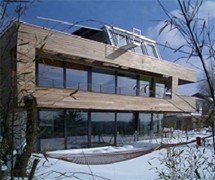
The number of passive houses in the Czech Republic is negligible; there are several hundred of them
 |
"Currently, there are about 700 to 800 passive houses in our country, nearly 700 of which have been supported by the Green Savings program," said the director of the association, which aims to promote passive houses.
Getting to precise numbers reflecting the development of new houses in passive standards is almost impossible. The Czech Statistical Office (CZSO) does not specifically monitor them, nor do the Association of Entrepreneurs in Construction. Their current figures are therefore based largely on estimates.
Bárta claims that around 150 to 200 passive houses were built in the Czech Republic last year. According to CZSO statistics, a total of 17,445 new apartments in family houses were built last year. "The number of passive houses is still minuscule, expressed in percentage terms as virtually zero," noted Bárta.
Proponents of passive housing argue that the small spread is mainly due to the lack of information among future owners. However, they tend to focus more on price. While a typical new building costs about 25,000 to 35,000 crowns per square meter, investing in a quality recuperation system in combination with a heat pump, possibly even a solar collector, and ensuring low air permeability of the envelope—basic components required for low-energy or passive standards—can increase construction costs by more than ten percent.
However, according to Bárta, the market for passive houses is slowly developing. "There is growing demand for energy-efficient homes. Some of them will be adjusted to reach passive standards," he said.
This trend has also been noticed by the ABF company, which recently organized the first edition of the For Pasiv fair focusing on low-energy, passive, and zero-energy buildings. "Market development shows that energy savings in construction will be the number one topic in this field in the coming years," noted Martin Přívětivý, director of the commercial team for the For Pasiv fair. According to him, this was also confirmed by the increased interest from exhibitors and visitors to the fair.
A passive house certificate is granted to a building if its annual heat consumption for heating does not exceed 15 kWh per square meter of living space. Additionally, the primary energy value of all energies, regardless of purpose, must not exceed 120 kWh per square meter of living space per year. The third criterion is the airtightness of the building, where a drop in air pressure in the building of 50 Pa compared to the surrounding atmosphere can lead to an infiltration of a maximum of 60 percent of the total volume of air in the building within one hour.
If the annual heat consumption for heating is in the range of 15 kWh to 50 kWh per square meter of living space, then according to Czech standards, it is considered a low-energy building. If the annual requirement is lower than five kWh, experts refer to it as a so-called zero-energy house, that is, one with zero energy needs.
The English translation is powered by AI tool. Switch to Czech to view the original text source.
0 comments
add comment
Related articles
0
05.01.2023 | The share of passive houses in completed buildings is growing annually
1
16.03.2021 | The number of new passive houses in the Czech Republic grew by about one third last year
0
10.02.2020 | The number of new passive houses in the Czech Republic increased by about a fifth last year
0
08.02.2019 | The share of new passive houses in the Czech Republic remained at six percent last year
0
08.02.2018 | The new director of the Passive House Center is Tomáš Vanický
0
09.02.2017 | The passive house of the year 2016 is a wooden building from Černošice
0
09.02.2017 | The share of new passive houses in the Czech Republic last year remained at 4.5%
0
04.07.2014 | A thousand young experts on passive houses are preparing to enter the market.











